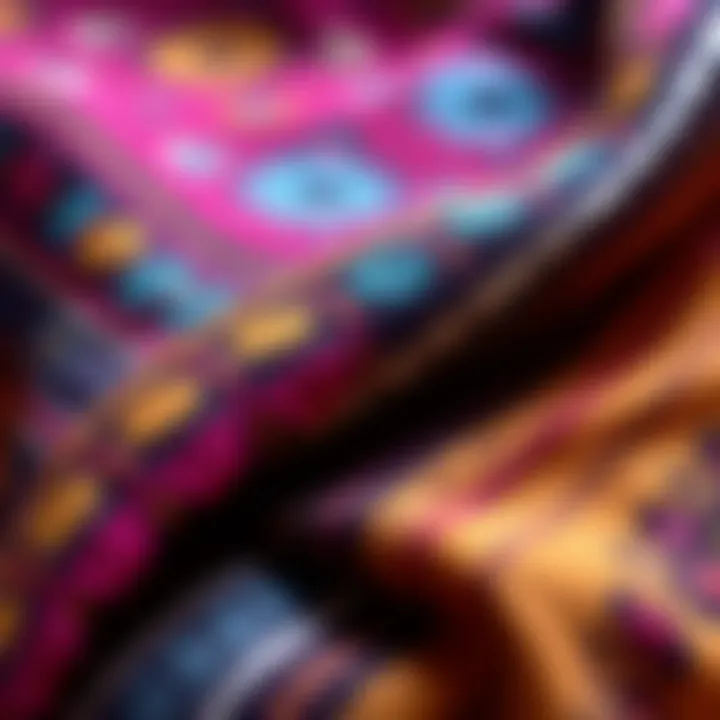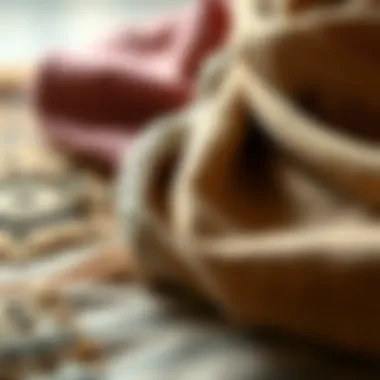Exploring the Cape Wrap Shawl: A Timeless Garment


Intro
The cape wrap shawl is more than just a piece of clothing. It embodies a rich tapestry of history, culture, and art. This multifunctional garment has graced various wardrobes around the world for centuries, adapting to the shifting sands of fashion trends and skirting the line between practicality and flair.
Across different cultures, the shawl has been utilized not just for warmth but also as a symbol of identity and tradition. The way a shawl drapes can tell a story—witnessing daily life, celebrations, or even sorrow. Hence, the cape wrap shawl is not solely a fashion statement; it holds a wealth of significance that invites us to pause and consider.
As we navigate the threads of its evolution, contemporary designers have breathed new life into the classic shawl, blending innovative materials with time-honored techniques. These modern iterations are not merely eye-catching; they echo a commitment to sustainable practices in the fashion industry. It's fascinating how the convergence of style and ethics can foster a resurgence of interest in such garments.
In the sections that follow, this exploration will take us through:
- The current trends in fashion that make the cape wrap shawl a must-have.
- Influential figures who have epitomized its style.
- The materials that define its quality and sustainability.
- Ethical brands championing this iconic piece while pushing for environmental accountability.
By the end of our journey, we will gain a clearer understanding of why the cape wrap shawl indeed deserves its place as a timeless garment, rooted in history yet fully relevant in today's fashion landscape.
Historical Background of the Cape Wrap Shawl
The cape wrap shawl, a versatile garment with deep cultural roots, serves as both a practical accessory and a symbol of identity across various societies. Understanding its historical background reveals how it has evolved and adapted to fit different needs while maintaining its significance. Through exploring the cape wrap shawl’s origins and its journey through time, we can appreciate its role as a staple in fashion and culture.
Cultural Origins
Early examples in various cultures
The origins of the cape wrap shawl can be traced back to various ancient civilizations. For instance, the Andean peoples of South America utilized woven textiles to create capes, which were often adorned with intricate patterns reflecting their cultural heritage. Similarly, in the Middle East, nomadic groups fashioned wraps from wool or silk, which helped them combat the harsh desert elements. These early examples highlight a common theme: the necessity of adaptability in clothing to suit environmental and cultural landscapes.
Key characteristics of these pieces include warmth and protection, which are especially important for those living in climates with extreme weather. Moreover, the craftsmanship involved in making these garments, often passed down through generations, showcases a rich tradition of textile art, which is a beneficial addition to this article's narrative. However, not all early shawls were created equal; the materials used could be both advantageous in durability and disadvantageous in terms of comfort, depending on the weaver’s technique and local resources.
Significance in traditional attire
In many cultures, the cape wrap shawl holds a place of pride as part of traditional attire. For example, in Ireland, the traditional woolen shawl has been cherished not only for its aesthetic qualities but also for its warmth and versatility, often worn by women in various settings from farm work to festive occasions. The importance of such garments in daily life and rituals highlights their significant role in cultural expression and identity.
This distinctive feature of the cape wrap shawl is that it serves numerous purposes, from functional to ceremonial. It has become a symbol of comfort, often draped around shoulders to provide warmth during gatherings or hardships. Thus, emphasizing its significance in traditional attire enriches this discussion, showcasing how a simple garment can encapsulate a community's values and aesthetic standards, while also being a popular choice for contemporary fashion.
Evolution Through Decades
Changes in design and fabric
As centuries rolled on, the cape wrap shawl underwent notable transformations. In the 19th century, the introduction of innovative fabrics changed the landscape of shawl-making. The rise of the Industrial Revolution led to mass production, which made shawls more accessible. New synthetic fibers began to replace natural materials, challenging traditional artisanal craftsmanship. This trend introduced a more extensive range of colors and patterns in shawls, allowing individuals to express their personal style more freely.
While modern designs focused on aesthetics, they often lacked the historical richness and local significance that traditional shawls held. This shift, although beneficial in terms of affordability, introduced a cultural disconnect. As we continue to explore this evolution, it is essential to recognize that while materials and designs changed, the essence of the cape wrap shawl as a quintessential clothing item maintained its core purpose of protection and beauty in everyday life.
Influence of fashion icons
In the 20th and 21st centuries, the cape wrap shawl found its way into the wardrobes of fashion icons and influencers alike. Renowned figures such as Coco Chanel and later celebrities like Audrey Hepburn donned various styles of shawl that captivated public attention. Their influence on style trends introduced the cape as a fashion statement, thus elevating the garment from mere functionality to high fashion.
This aspect of influence proves vital for this article as it illustrates the garment's journey from practical wear to emblematic fashion piece. However, the rapid evolution can also lead to less appreciation for the art of shawl-making and its inherent beauty, something that the fast-paced fashion industry sometimes neglects.
Thus, it is apparent that the cape wrap shawl is not merely a garment, but a living narrative interwoven with the fabric of history, culture, and personal expression.
Design Elements of the Cape Wrap Shawl
The design elements of the cape wrap shawl are critical for understanding its significance as both a fashion accessory and a cultural artifact. These elements demarcate how this garment can be utilized across various contexts, ensuring not just aesthetic appeal but also functional versatility. The interplay of style, fabric, and its adaptability to different occasions transcends mere fashion, making the cape wrap shawl an enduring staple in wardrobes around the world.
Styles and Variations
Classic vs. Modern Designs
The distinction between classic and modern designs of the cape wrap shawl highlights its evolution in the fashion realm. Classic designs often embrace traditional cuts and materials, favoring elegant lines and timeless patterns like houndstooth or paisley. These designs symbolize enduring styles that have been appreciated across generations, appealing to those keen on historical craftsmanship.
On the other hand, modern designs introduce asymmetries, unique closures, or even bold prints that cater to contemporary tastes. The key characteristic of classic designs rests in their subtlety—these shawls envelop the wearer in sophistication without yelling for attention. However, they might lack the boldness that modern designs offer, which often experiment with vibrant colors and unconventional shapes, trading some “timelessness” for a current edge.
Both styles carry their unique features. The classic shawl's advantage lies in its versatility for formal occasions, while modern designs can be favored for casual outings or festivals, where current trends take precedence. As such, the varied consumer preferences mark a fascinating exploration of how these designs fulfill different style needs.
Regional Differences in Design
Regional differences in the design of cape wrap shawls illustrate how local culture, environment, and craftsmanship weave into fabric artistry. From the richly embroidered shawls of South Asia to the sleek, minimalistic styles found in Scandinavian countries, each region brings forth a distinct flavor. Such diversity challenges the wearer’s perception of what a shawl signifies—be it as a statement piece or a cultural symbol.
For instance, the Nepalese shawl often incorporates intricate patterns representing their mythology, while Indian shawls frequently feature vibrant colors that echo local festivals. The key aspect here is the artisan’s heritage, which is visibly embedded in the fabric's details. Enthusiasts often appreciate these differences, selecting shawls that not only complement their attire but also resonate with their values and connections to specific cultures.
This richness in design variations presents advantages and disadvantages in selection. Buyers have a broader array to choose from, but they may grapple with understanding the cultural narratives attached to each variant. The unifying theme throughout these regional features, however, shines through in how these shawls narrate stories of identity and belonging, reflecting distinct heritages within a global narrative.
Versatility in Usage
Layering Techniques
The layering techniques associated with the cape wrap shawl speak to its practicality. One of the shawl's major benefits is how easily it can be styled over various outfits. Whether draped over a simple T-shirt or wrapped around a formal dress, it elevates the entire look without much effort.
Creative layering—like wearing the shawl under a tailored coat or over a structured top—offers wearers numerous options. The freedom these techniques allow not only enhances personal style but also adapts to changing climates and occasions, making the shawl a valuable addition to anyone's wardrobe.


However, the challenge lies in knowing how to layer correctly to avoid looking bulky. Properly styled, a well-chosen shawl can highlight the wearer’s shape while providing warmth. Thus, understanding effective layering techniques can transform the shawl into a powerful statement piece.
Seasonal Adaptations
The adaptability of the cape wrap shawl across seasons underscores its importance in fashion. Seasonal adaptations allow it to transition elegantly from winter to summer. For example, heavier fabrics like wool are ideal for colder months, offering warmth and coziness, while lighter materials such as cotton or linen come to the fore during warmer seasons, providing breathability and ease.
The key characteristic of seasonal adaptability is its ability to be styled differently depending on temperature. A winter shawl can be cinched at the waist with a trendy belt for added warmth, while a lightweight summer version can be draped effortlessly as a throw over a sundress. With simple shifts in styling and fabric choice, the shawl remains relevant year-round.
However, this adaptability can pose a dilemma for buyers who might feel overwhelmed by the variety of designs suitable for different seasons. Not all shawls are created equal; therefore, understanding the properties of various fabrics can help consumers make more informed decisions. This insight can ultimately enhance their wardrobe options, allowing them to enjoy the timeless elegance of the cape wrap shawl throughout the year.
Materials and Fabric Innovations
When it comes to crafting a cape wrap shawl, the choice of materials plays a significant role in its overall appeal and functionality. Different fabrics not only affect the look of the shawl but also its comfort, durability, and environmental impact. In an era of conscientious consumption, understanding the evolution of materials and the innovations in fabric can deeply enhance appreciation for this timeless garment.
Common Fabrics Used
Wool, cashmere, and blends
Wool and its luxurious cousin, cashmere, have long been favorites among shawl enthusiasts. Wool, known for its insulation properties and moisture-wicking abilities, keeps the wearer warm without causing overheating. Cashmere, on the other hand, boasts an incredibly soft texture, giving the wearer an elegant and cozy feel. Blends of these materials often introduce enhanced durability while maintaining comfort.
A unique feature of wool, cashmere, and their blends is their adaptability across seasons. Because of their inherent properties, they can keep you warm in winter and are lightweight enough for cooler spring days. However, one must consider that these fabrics require specific care to maintain their softness and shape, which can be a drawback for some consumers who prefer low-maintenance solutions.
Natural vs. synthetic fibers
Natural fibers, such as cotton and linen, are often pitted against synthetic options like polyester and nylon. Natural fibers tend to breathe better and are generally more comfortable against the skin, making them a popular choice for those who value comfort alongside style. Conversely, synthetic fibers are renowned for their strength and resistance to wrinkles, mold, and mildew, making them practical for everyday wear.
While natural fibers mesh well in a sustainable lifestyle and support a lower environmental footprint, synthetic fibers often come at a lower price point and require less delicate care. The trade-off here is significant: the environmental effects of producing synthetic materials are usually far worse than their natural counterparts, despite their durability.
Sustainable Material Choices
With growing awareness about environmental issues, sustainable materials are becoming crucial in the fashion industry. Designers are now looking at alternative fabrics that not only reduce ecological impact but also tell a story.
Organic textiles
Organic textiles are fabrics made from materials cultivated without the use of harmful chemicals or pesticides. This focus on eco-friendliness not only benefits the environment but also enhances the garment’s quality. Fabrics like organic cotton, for instance, offer a breathable, biodegradable alternative that is gentle on the skin.
The primary characteristic of organic textiles is their sustainable method of production, which supports biodiversity and soil health. So, choosing these textiles means you're making a commitment to responsible manufacturing practices. However, organic fabrics may often carry a higher price tag, which can limit their accessibility.
Recycled materials
Recycled materials represent a blend of sustainability and innovation. By repurposing old textiles into new fabric, the fashion industry can dramatically reduce waste. This approach not only lessens the demand for virgin resources but also decreases the carbon footprint associated with textile production.
The key characteristic of recycled materials is their versatility. Fabrics made from recycled PET bottles or old garments can be durable, stylish, and sustainable. Yet, the challenge lies in the perception – many consumers may still hesitate to embrace these materials due to the misconception about their quality. However, with innovations in recycling processes, the comfort and performance of these fabrics have improved significantly, making them a worthwhile investment for eco-conscious wearers.
"Understanding the materials that go into crafting garments like the cape wrap shawl not only informs better purchasing decisions but also fosters a deeper connection to fashion and its wider implications."
In summary, exploring materials and fabric innovations not only enhances the allure of the cape wrap shawl but also solidifies its status as a garment of significance in both fashion and environmental contexts. Insights into the variety of fabrics help us appreciate not just the aesthetic qualities but also the stories and values woven into every piece.
Styling the Cape Wrap Shawl
Styling the cape wrap shawl isn't just about draping a piece of fabric over your shoulders. It's an art, a way of expressing your individuality while embracing the history and cultural significance behind this garment. With its flexible design and myriad ways to wear it, the cape wrap shawl can suit various scenarios, making it an essential piece in any wardrobe. Knowing how to style it can elevate your attire, enhancing personal aesthetics while ensuring comfort and practicality.
Occasion-based Styling
Casual wear tips
When you think of a casual day out, the cape wrap shawl can be your best friend. It's perfect for those laid-back outings when comfort is key but you still want to look put-together. One popular approach is to pair the shawl with a simple t-shirt and a good pair of jeans. You could opt for a light or brightly colored shawl, creating a cheerful contrast with your outfit without overwhelming it. The key here is to embody that effortless chic—something that says, "I just threw this on, but I still look fab!"
A unique feature of casual wear with a cape wrap shawl is its adaptability. You can switch from a morning brunch to a lovely stroll in the park just by adjusting how you wear it. It’s like a garment that has multiple personas! The shawl can also serve as a lightweight layer during cooler evenings, greatly enhancing its functionality. However, one downside could be that if not draped carefully, it might occasionally slip off or get caught in the wind.
Formal events styling
On the flip side, the cape wrap shawl can make an astounding centerpiece for formal occasions. Imagine walking into an elegant event, your wrap draped gracefully over a sleek evening gown or a sophisticated suit. For these instances, choosing a shawl made from high-quality fabric, like silk or cashmere, adds a touch of luxury that aligns well with the formal environment.
The hallmark of formal styling with a cape wrap lies in its ability to lend an air of sophistication without trying too hard. Often, it’s the subtlety that stands out. You may opt for a solid color that complements your outfit or go for a patterned shawl that delights the eye. The advantage of this versatility is that the shawl doesn't just act as a fashion accessory; it can also provide warmth and comfort, which might be overlooked at glitzy venues. A disadvantage, however, is that the shawl may overshadow more elaborate attire if not chosen wisely.
Layering with Other Garments
Pairing with dresses
When layering the cape wrap shawl over dresses, one finds a synergy that is both graceful and eye-catching. Whether it’s a flowy maxi dress for those summer afternoons or a structured cocktail dress for evening gatherings, wearing the shawl can bring a new dimension to your look. A delicate lace shawl over a solid dress might transform a simple outfit into something enchanting, showcasing the uniqueness of both pieces.
This pairing allows for versatility; short dresses can be enhanced, while long ones can be elegantly draped. However, one should take care not to take away from the overall silhouette of the dress. Done right, this creates a breathtaking ensemble, but if mismatched, the layers can end up looking unsightly and confusing.
Integrating into everyday outfits
Incorporating the cape wrap shawl into everyday outfits brings a refreshing twist to casual wear. For instance, wrapping it around your shoulders with a simple ensemble of leggings and a tunic top adds instant flair. It’s as if you adorn your basic outfit with an accessory that tells a story, blending comfort with style seamlessly.
This style element makes the shawl a multifunctional item that adapts to many scenarios, allowing you to easily transition from a work setting to an after-work gathering. However, depending on the season, the thickness of the shawl can either be a blessing or a curse; a lightweight shawl might work well in warmer months but leave you feeling unprotected on chilly days. Ultimately, integrating this beautiful garment into daily life allows one to appreciate both its aesthetic value and its practicality.


Care and Maintenance
Caring for a cape wrap shawl is critical, not just for longevity but also to maintain its aesthetic appeal. Given the diverse materials and symbolic significance of these garments, proper care helps preserve their unique characteristics and prolongs their life amid changing fashions. Understanding various care techniques ensures that you enjoy your shawl’s beauty for years to come.
Cleaning Techniques
In maintaining the vibrant look and feel of a cape wrap shawl, cleaning methods play a vital role. Here, we explore two primary options: hand washing and machine washing, as well as the consideration for dry cleaning.
Hand washing vs. machine washing
When it comes to cleaning your shawl, hand washing is often considered the gentlest technique. This method not only minimizes the risk of damaging delicate fabrics but also allows for a more careful approach to stains or dirt. Washing by hand helps you pay close attention to the fabric's needs, particularly with materials like cashmere or silk.
On the other hand, machine washing is convenient for the busy individual. If your shawl is made from more durable material, such as wool poly blends, using a delicate cycle with cold water can maintain its integrity. However, the key characteristic of machine washing lies in the risk of wear and tear, especially if the shawl gets tangled or twisted during the wash. If you choose this route, consider placing your shawl in a mesh laundry bag for additional protection.
Ultimately, the choice between hand washing and machine washing depends on the shawl’s fabric and your lifestyle needs.
"The delicate dance of care is what keeps our cherished pieces alive and thriving."
Dry cleaning considerations
For those who prefer professional cleaning, dry cleaning can be a suitable option. This method uses a special solvent and is particularly beneficial for garments with intricate designs or embellishments that may be damaged by water. Moreover, dry cleaning can remove tough stains without the wear from traditional washing.
Yet, it’s important to note that dry cleaning isn’t universally recommended for every fabric. Some natural fibers may react poorly to the chemicals used, leading to fading or texture loss. The unique feature of dry cleaning is its ability to rejuvenate worn fabrics, yet it can be costlier over time and might not align with a sustainable lifestyle. Before making a decision, consider the shawl's fabric composition and the value you place on its preservation.
Storage Recommendations
Proper storage ensures that your cape wrap shawl remains in excellent condition, free from creases and potential damage caused by environmental factors. Here are some considerations to enhance the longevity of your shawl.
Best practices for longevity
To truly extend the life of your shawl, best practices for longevity involve careful storage techniques. Ideally, shawls should be stored folded and laid flat to avoid unwanted creases. Keeping your shawl in a breathable cotton bag can help protect it from dust and moisture. Avoid plastic bags as they can trap moisture and create a breeding ground for mildew.
Also, consider the location where you store your shawl. A cool, dark area away from direct sunlight is essential. Exposure to harmful UV rays can lead to fading, particularly in vibrant fabrics.
Avoiding common pitfalls
When it comes to storing your shawl, avoiding common pitfalls is vital. One major mistake is cramming the shawl into an already full space, which can lead to crushing and permanent creases. Additionally, temperature fluctuations are a major concern; keeping a shawl in a hot attic or a damp basement can drastically affect the fabric's integrity.
Another pitfall is neglecting to clean the shawl before storing it away. Leftover dirt or stains can set in over time, making them difficult to remove later. Consequently, a little prevention goes a long way in keeping your shawl looking pristine and ready to wear when the moment calls for it.
Cultural Significance and Symbolism
The cape wrap shawl is more than just a piece of clothing; it carries layers of meaning and cultural heritage. Throughout history, it has served various roles, from practical utility to a canvas for self-expression. Understanding its cultural significance provides deeper insight into why this garment remains a timeless staple across diverse wardrobes.
The Cape Wrap in Different Cultures
Identity and Representation
In many cultures, the cape wrap shawl serves as a reflection of identity. It can symbolize belonging to a specific community or heritage, part of the rich tapestry that crafts individual and collective narratives. For instance, in indigenous cultures, intricate patterns stitched into shawls often carry stories or signify tribal marks. This element of identity and representation is crucial. Wearing such a shawl can be an act of embracing one’s culture, showcasing pride and connection.
Furthermore, shawls can be multifunctional in social contexts—worn at ceremonies, family gatherings, or even daily life, they encapsulate a sense of belonging and societal roles. That makes them a popular choice for those wanting to express their cultural roots. It's like wearing your heart on your sleeve, or in this case, around your shoulders.
- Unique Aspect: Shawls serve not just as garments but as storytellers of one's heritage.
- Advantages: They promote cultural pride and awareness.
Evolution of Cultural Motifs
Cultural motifs on shawls have changed over the years. They often embody the artistic style and societal values of different eras. The evolution of cultural motifs showcases adaptability in design while retaining traditional charm. As societies evolve, so do the patterns and designs used in shawls; drawing inspiration from modern art movements or even social movements.
This constant evolution keeps the shawl relevant, allowing it to resonate with both the young and the old. Customization in designs, influenced by technology and global connectivity, makes it a favorite among artisans and wearers alike.
- Unique Feature: Motifs can marry tradition with contemporary flair, creating something that honors the past while speaking to the present.
- Advantages: They demonstrate flexibility in design, appealing to diverse audiences.
Symbolism of the Shawl
Comfort and Protection
The symbolic nature of the shawl extends into themes of comfort and protection. In various cultures, wraps serve not only to keep warmth but also as a shield against the elements. Many people feel safe and cozy when they drape themselves in a shawl, making it a comforting garment that appeals to emotional states as well as physical ones.
Its utility spans beyond warmth; it can provide a sense of security in social environments. The act of wrapping oneself in a shawl can be quasi-therapeutic, a means of retreat from the world when needed. This emotional link to comfort adds an invaluable layer to its significance.
- Unique Characteristic: Shawls can be a personal refuge or a communal emblem of care.
- Advantages: They foster emotional well-being while serving a functional role.
Fashion as Expression
The intersection of fashion and expression through shawls cannot be understated. The cape wrap shawl allows individuals to project their personality and style. Different fabrics, colors, and ways to style a shawl can tell someone’s story without saying a word. Whether bold and colorful or muted and sophisticated, these shawls can capture an individual's mood or intentions.
People often choose shawls that resonate with their style, mixing and matching them to create eye-catching ensembles. The diversity in design options offers a powerful platform for personal expression, encouraging wearers to showcase their individuality.
- Unique Feature: Each shawl is a reflection of the wearer’s personality.
- Advantages: They provide a versatile means of showcasing personal style and creativity.


Understanding the cultural significance and symbolism of the cape wrap shawl not only enriches the narrative surrounding this garment but also enhances our appreciation for its role in personal and collective identity. These layers of meaning transform a simple accessory into a profound statement in both fashion and culture.
The Cape Wrap Shawl in Contemporary Fashion
As we take a look at the contemporary fashion scene, the cape wrap shawl stands out not just as a garment, but as a statement piece steeped in cultural significance. It serves multiple purposes—acting as a cozy layer on chilly days and as an eye-catching accessory. Its adaptability to various fashion styles makes it a favorite among those who appreciate versatility. The shawl symbolizes a fusion of tradition and modernity that appeals to both seasoned fashionists and newcomers alike.
Current Trends
Influence of social media
Social media has become a powerful tool in the fashion industry. The impact of platforms like Instagram and TikTok cannot be overstated. Here, trends can rise and fall at the snap of a finger, and the cape wrap shawl has shown to be no exception. With influencers showcasing innovative ways to style them in their daily outfits, the shawl receives an immense boost in visibility.
One key characteristic of this influence is the immediacy of fashion content. A casual photo on Instagram can inspire countless users, spreading style ideas like wildfire. This makes the cape wrap shawl a highly desirable item for those wanting to keep their wardrobe fresh and in tune with the latest fashions.
A unique feature of social media is its capacity for community-building around fashion. Enthusiasts share tips, hacks, and even DIY projects for personalization, enhancing the garment's appeal. However, the fast-paced nature of trends may also lead to oversaturation, where the shawl could lose its singular edge amidst a sea of competitors.
Modern fashion week showcases
Modern fashion weeks globally serve as a highlight reel for the latest in creativity and craftsmanship. Designers often use the cape wrap shawl in collections to showcase their interpretation of this timeless piece. The key takeaway here is that fashion weeks have a critical role in shaping popular tastes. They introduce the cape wrap shawl as not just practical, but an essential item adorned with unique designs that attract attention.
One notable feature of these showcases is often the striking visuals and artistic presentations. Designers creatively incorporate the shawl into their lines, presenting it in innovative ways, which adds depth to its appeal. While fabulous high-fashion presentations captivate an audience, they might make the shawl appear unattainable to the average consumer, posing a challenge for widespread popularity.
Influence of Designers
High-end brands
High-end brands have a significant impact on trends surrounding the cape wrap shawl. Designers like Gucci and Chanel introduce high-quality materials and unique styles, elevating the shawl to a luxury item. This characteristic gives the shawl an air of sophistication and allure that appeals to fashion-conscious individuals. When these brands embrace the cape wrap, it becomes synonomous with exclusivity.
These high-end offerings often emphasize craftsmanship and use premium fabrics that enhance the overall experience of wearing a shawl. However, the high price point can act as a double-edged sword, making it less accessible for a broader audience.
Accessibility in fast fashion
In contrast to the luxurious offerings, fast fashion retailers like H&M and Zara have made the cape wrap shawl widely accessible. This democratization of fashion allows anyone—from college students to working professionals—to step into the world of trendy shawls. By producing stylish options at a lower price point, these brands have played a vital role in bringing the shawl to the masses.
The unique selling point here lies in the affordability combined with a rapid turnover of styles. Consumers can find shawls that mimic high-fashion trends without draining their wallets. However, there are drawbacks, such as potential concerns over production ethics, sustainability, and the quality of materials used. Many consumers remain increasingly aware of these factors, leading to an ongoing conversation about the balance between affordability and ethical fashion.
Practical Considerations
When it comes to the cape wrap shawl, practical considerations are key in ensuring that the garment serves its purpose not just as a stylish accessory, but also as a functional piece of clothing. Selecting the right shawl can enhance one’s wardrobe while making a statement about personal values, such as sustainability and ethical production. As we delve deeper into the nuances of choosing a shawl, we can appreciate how both fit and ethics intertwine to influence consumer decisions today.
Choosing the Right Shawl
Factors to consider
When contemplating the right shawl, there are several factors that come into play. First among these is the material. Shawls can be made from various fabrics such as wool, silk, or cotton, each bringing its own flair and utility. For instance, wool shawls tend to provide warmth, making them ideal for colder months, while lightweight cotton options thrive during summer.
Another element to consider is the design. A pattern or color may resonate personally or suit a specific occasion. Functionality also plays a vital role; some shawls offer extra features, like pockets, which can be handy for everyday use.
- Weather conditions: Your location may dictate the thickness or material of the shawl.
- Personal style: Reflect on colors and patterns that align with your fashion sense.
- Budget: Consider options that fit within your budget while still maintaining quality.
The unique charm of selecting the right shawl lies in the ability to infuse personal flair while also considering these important factors.
Fit and functionality
Fit and functionality are imperative when it comes to a shawl. You want to ensure that it wraps comfortably around your body and drapes elegantly. A well-fitted shawl should complement your silhouette rather than overwhelm it. The versatility of wearing it in different styles—over the shoulders, wrapped around the neck, or belted—adds to its practical appeal.
Moreover, functionality can include features like being packable for travel. A lightweight and compressible shawl allows for easy transport, making it an essential piece during vacations.
- Comfort: Ensure it doesn’t tug or constrict as you move about.
- Usage versatility: Think about how often you’ll wear it and in what contexts—formal or casual.
Ultimately, the fit and functionality ensure that a cape wrap shawl serves its wearer gracefully in a multitude of situations.
Ethics in Shawl Production
Moving from personal choice to a collective responsibility, ethics in shawl production is increasingly becoming a focal point for consumers. Awareness around ethical sourcing and production practices is vital in today's fashion landscape, where buyers are not just looking for style but also sustainability.
Importance of fair trade
Fair trade practices are crucial in ensuring that artisans and workers are compensated fairly for their craftsmanship. This contributes to the well-being of individuals and their communities, pushing towards an ethical approach to fashion that consumers are increasingly demanding. The hallmark of fair trade is transparency in the supply chain, which allows buyers to make informed choices.
This concept not only upholds human dignity but also enhances the quality of the goods produced. When workers are treated well, their craft improves, leading to more heartfelt and carefully made products.
- Empowerment: It facilitates empowerment among marginalized communities.
- Quality assurance: Products often reflect the artisans’ cultural heritage and attention to detail.
Engaging with brands that practice fair trade fosters a broader impact on global communities.
Supporting local artisans
Steering support towards local artisans offers a reciprocal relationship; consumers obtain unique, high-quality items while contributing to the preservation of traditional crafts. Choosing a shawl made by local hands not only enhances one’s wardrobe but also tells a story about cultural heritage and craftsmanship. By prioritizing local production, consumers help curb the environmental impact associated with mass production.
- Cultural preservation: Local artisans often incorporate traditional techniques that are at risk of fading.
- Community enrichment: Supporting them strengthens local economies.
In short, supporting local artisans provides consumers with ethical fashion choices while ensuring that traditional crafts remain vibrant.
As we wrap up these practical considerations, it is evident that the right cape wrap shawl serves not just an aesthetic or functional purpose but also embodies the values that resonate with modern consumers. Whether considering fit, functionality, or the ethics of its production, thoughtful choices can lead to garments that are both timeless and meaningful.















